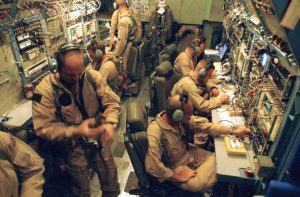How Does the Military Communicate?
By Sarah-Claire jordan
 When dealing with problems that can determine the outcome of something as serious as a war, communicating exactly what you mean to say is crucial. If a group of soldiers can’t understand what their commanding officer is trying to tell them over the radio, they could get killed, reveal their position to the enemy, and any number of other negative consequences. The person relaying the message needs to do so in a way that the person receiving will understand, and the person receiving the message needs to be able to quickly understand the message and respond in a coherent manner.
When dealing with problems that can determine the outcome of something as serious as a war, communicating exactly what you mean to say is crucial. If a group of soldiers can’t understand what their commanding officer is trying to tell them over the radio, they could get killed, reveal their position to the enemy, and any number of other negative consequences. The person relaying the message needs to do so in a way that the person receiving will understand, and the person receiving the message needs to be able to quickly understand the message and respond in a coherent manner.
This has been an issue that has long plagued the militaries of practically every nation in the world, but the final touches on the solution were made in the 1950s. Now every branch of the U.S. military, as well as airlines and other organizations that need to communicate effectively by radio, uses the NATO phonetic alphabet, along with some code words, to communicate over the radio. This alphabet consists of entire words, all two or three syllable, that start with each letter of the English alphabet, that are used in place of letters to spell out words, locations, codes, and more.
The challenge goes beyond just creating a system that would work within one nation’s military. As we all know thanks to history class, most major wars involve more than one nation on either side. What happens when you, and English speaker, have to communicate your position to a Portuguese speaker, for instance? You can’t do it in your native language, so you have to figure out how to spell things out. This is where the NATO phonetic alphabet comes in, and saves the day thanks to the many revisions and rigorous testing it went through to assure that it was understandable and effective for everyone who uses the English alphabet.
The words that were finally chosen to make up the phonetic alphabet used by the military and many other organizations are as follows: Alpha, Bravo, Charlie, Delta, Echo, Foxtrot, Golf, Hotel, India, Juliett, Kilo, Lima, Mike, November, Oscar, Papa, Quebec, Romeo, Sierra, Tango, Uniform, Victor, Whiskey, X-ray, Yankee, and Zulu. Hyphens are called “Dash”, and there are codes for entire words as well that can’t just be spelled out. Those include the familiar “Roger”, “Mayday”, and “Wilco”. “Roger” is used to signify that a message has been received and understood, and is short for “roger message”. “Roger” used to mean “R” but was replaced with “Romeo,” but lives on in the form of the code word.
Though this form of communication is really only used with radio communications, it proved, and continues to prove, to be an essential part of military training and life. If it weren’t for the years of testing and revising that went into creating the NATO phonetic alphabet, our militaries would not be able to communicate as effectively as they do now, not to mention those who work in commercial aviation would have a tough time getting important information across to those on the ground and vice versa. Perhaps if we were a bit more observant in our everyday lives, we would be able to grasp how significant this communication system is.
Learn more about government translation services.
Category: Business Translation








